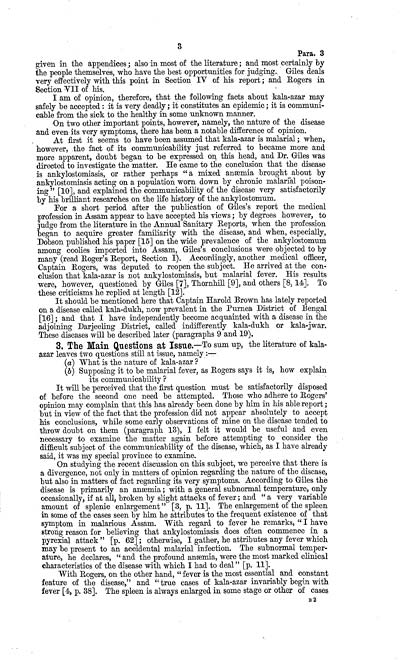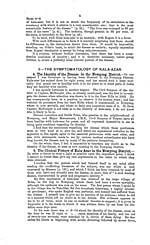Medicine - Disease > Report on the nature of kala-azar
(11) Page 3
Download files
Individual page:
Thumbnail gallery: Grid view | List view

3
Para. 3
given in the appendices; also in most of the literature; and most certainly by
the people themselves, who have the best opportunities for judging. Giles deals
very effectively with this point in Section IV of his report; and Rogers in
Section VII of his.
I am of opinion, therefore, that the following facts about kala-azar may
safely be accepted : it is very deadly; it constitutes an epidemic; it is communi-
cable from the sick to the healthy in some unknown manner.
On two other important points, however, namely, the nature of the disease
and even its very symptoms, there has been a notable difference of opinion.
At first it seems to have been assumed that kala-azar is malarial; when,
however, the fact of its communicability just referred to became more and
more apparent, doubt began to be expressed on this head, and Dr. Giles was
directed to investigate the matter. He came to the conclusion that the disease
is ankylostomiasis, or rather perhaps "a mixed anmia brought about by
ankylostomiasis acting on a population worn down by chronic malarial poison-
ing" [10], and explained the communicability of the disease very satisfactorily
by his brilliant researches on the life history of the ankylostomum.
For a short period after the publication of Giles's report the medical
profession in Assam appear to have accepted his views; by degrees however, to
judge from the literature in the Annual Sanitary Reports, when the profession
began to acquire greater familiarity with the disease, and when, especially,
Dobson published his paper [15] on the wide prevalence of the ankylostomum
among coolies imported into Assam, Giles's conclusions were objected to by
many (read Roger's Report, Section I). Accordingly, another medical officer,
Captain Rogers, was deputed to reopen the subject. He arrived at the con-
clusion that kala-azar is not ankylostomiasis, but malarial fever. His results
were, however, questioned by Giles [7], Thornhill [9], and others [8, 14]. To
these criticisms he replied at length [12].
It should be mentioned here that Captain Harold Brown has lately reported
on a disease called kala-dukh, now prevalent in the Purnea District of Bengal
[16]; and that I have independently become acquainted with a disease in the
adjoining Darjeeling District, called indifferently kala-dukh or kala-jwar.
These diseases will be described later (paragraphs 9 and 19).
3. The Main Questions at Issue.-To sum up, the literature of kala-
azar leaves two questions still at issue, namely:-
(a) What is the nature of kala-azar ?
(b) Supposing it to be malarial fever, as Rogers says it is, how explain
its communicability ?
It will be perceived that the first question must be satisfactorily disposed
of before the second one need be attempted. Those who adhere to Rogers'
opinion may complain that this has already been done by him in his able report;
but in view of the fact that the profession did not appear absolutely to accept
his conclusions, while some early observations of mine on the disease tended to
throw doubt on them (paragraph 13), I felt it would be useful and even
necessary to examine the matter again before attempting to consider the
difficult subject of the communicability of the disease, which, as I have already
said, it was my special province to examine.
On studying the recent discussion on this subject, we perceive that there is
a divergence, not only in matters of opinion regarding the nature of the disease,
but also in matters of fact regarding its very symptoms. According to Giles the
disease is primarily an anmia; with a general subnormal temperature, only
occasionally, if at all, broken by slight attacks of fever; and " a very variable
amount of splenic enlargement" [3, p. 11]. The enlargement of the spleen
in some of the cases seen by him he attributes to the frequent existence of that
symptom in malarious Assam. With regard to fever he remarks, " I have
strong reason for "believing that ankylostomiasis does often commence in a
pyrexial attack" [p. 62]; otherwise, I gather, he attributes any fever which
may be present to an accidental malarial infection. The subnormal temper-
ature, he declares, " and the profound anmia, were the most marked clinical
characteristics of the disease with which I had to deal" [p. 11].
With Rogers, on the other hand, " fever is the most essential and constant
feature of the disease," and "true cases of kala-azar invariably begin with
fever [4, p. 38]. The spleen is always enlarged in some stage or other of cases
B2
Para. 3
given in the appendices; also in most of the literature; and most certainly by
the people themselves, who have the best opportunities for judging. Giles deals
very effectively with this point in Section IV of his report; and Rogers in
Section VII of his.
I am of opinion, therefore, that the following facts about kala-azar may
safely be accepted : it is very deadly; it constitutes an epidemic; it is communi-
cable from the sick to the healthy in some unknown manner.
On two other important points, however, namely, the nature of the disease
and even its very symptoms, there has been a notable difference of opinion.
At first it seems to have been assumed that kala-azar is malarial; when,
however, the fact of its communicability just referred to became more and
more apparent, doubt began to be expressed on this head, and Dr. Giles was
directed to investigate the matter. He came to the conclusion that the disease
is ankylostomiasis, or rather perhaps "a mixed anmia brought about by
ankylostomiasis acting on a population worn down by chronic malarial poison-
ing" [10], and explained the communicability of the disease very satisfactorily
by his brilliant researches on the life history of the ankylostomum.
For a short period after the publication of Giles's report the medical
profession in Assam appear to have accepted his views; by degrees however, to
judge from the literature in the Annual Sanitary Reports, when the profession
began to acquire greater familiarity with the disease, and when, especially,
Dobson published his paper [15] on the wide prevalence of the ankylostomum
among coolies imported into Assam, Giles's conclusions were objected to by
many (read Roger's Report, Section I). Accordingly, another medical officer,
Captain Rogers, was deputed to reopen the subject. He arrived at the con-
clusion that kala-azar is not ankylostomiasis, but malarial fever. His results
were, however, questioned by Giles [7], Thornhill [9], and others [8, 14]. To
these criticisms he replied at length [12].
It should be mentioned here that Captain Harold Brown has lately reported
on a disease called kala-dukh, now prevalent in the Purnea District of Bengal
[16]; and that I have independently become acquainted with a disease in the
adjoining Darjeeling District, called indifferently kala-dukh or kala-jwar.
These diseases will be described later (paragraphs 9 and 19).
3. The Main Questions at Issue.-To sum up, the literature of kala-
azar leaves two questions still at issue, namely:-
(a) What is the nature of kala-azar ?
(b) Supposing it to be malarial fever, as Rogers says it is, how explain
its communicability ?
It will be perceived that the first question must be satisfactorily disposed
of before the second one need be attempted. Those who adhere to Rogers'
opinion may complain that this has already been done by him in his able report;
but in view of the fact that the profession did not appear absolutely to accept
his conclusions, while some early observations of mine on the disease tended to
throw doubt on them (paragraph 13), I felt it would be useful and even
necessary to examine the matter again before attempting to consider the
difficult subject of the communicability of the disease, which, as I have already
said, it was my special province to examine.
On studying the recent discussion on this subject, we perceive that there is
a divergence, not only in matters of opinion regarding the nature of the disease,
but also in matters of fact regarding its very symptoms. According to Giles the
disease is primarily an anmia; with a general subnormal temperature, only
occasionally, if at all, broken by slight attacks of fever; and " a very variable
amount of splenic enlargement" [3, p. 11]. The enlargement of the spleen
in some of the cases seen by him he attributes to the frequent existence of that
symptom in malarious Assam. With regard to fever he remarks, " I have
strong reason for "believing that ankylostomiasis does often commence in a
pyrexial attack" [p. 62]; otherwise, I gather, he attributes any fever which
may be present to an accidental malarial infection. The subnormal temper-
ature, he declares, " and the profound anmia, were the most marked clinical
characteristics of the disease with which I had to deal" [p. 11].
With Rogers, on the other hand, " fever is the most essential and constant
feature of the disease," and "true cases of kala-azar invariably begin with
fever [4, p. 38]. The spleen is always enlarged in some stage or other of cases
B2
Set display mode to: Large image | Zoom image | Transcription
Images and transcriptions on this page, including medium image downloads, may be used under the Creative Commons Attribution 4.0 International Licence unless otherwise stated. ![]()
| India Papers > Medicine - Disease > Report on the nature of kala-azar > (11) Page 3 |
|---|
| Permanent URL | https://digital.nls.uk/74580926 |
|---|




